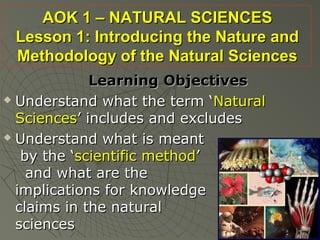This document introduces the natural sciences as an area of knowledge. It defines natural sciences as knowledge of observable objects and processes in nature, such as biology and physics, as distinguished from abstract sciences like mathematics. It describes the scientific method as involving observation, hypothesis formation, prediction, and experimental testing to confirm or falsify hypotheses. Personal knowledge and imagination play a role in scientific discovery alongside shared experimentation and observation. Questions are raised about whether scientific knowledge can be considered absolutely true or reliable given its tentative nature and reliance on indirect observation tools.





























